
Changes on the Montreal hockey scene that were viewed as significant prior to the start of the 1924-25 NHL campaign, perhaps paled next what occured in the city in this season.
While the NHL continued to evolve at a rapid clip, the natural order of things had a dramatic effect on the Canadiens.
All matters taken all together, it would not be business as usual for the Montreal Canadiens in 1925-26.
Compared to other professional hockey franchises, the Canadiens had been quite successful in outlasting all NHA and NHL counterparts since they began in 1909. Along with the equally solid Ottawa Senators, the Canadiens and their star players were constants on the hockey scene.
BUILDING A TRADITION
Through the years, there were few elements that would remain with the team annually through good times and bad. Team owners came and went. Arena's perished and new one's were built. The league itself evolved and grew. Rules of the games were being altered.
Stars such as Newsy Lalonde and Didier Pitre, who had long tenures with the Canadiens were ably replaced by the younger legs of Aurel Joliat and Howie Morenz. There were two Stanley Cup championships to the team's credit, as well as three other appreances in the Cup final. First place finishes were followed by last place falls.
Through all these paradoxes, one constant on the team had remained in place, almost since the club's inception.
VEZINA WAS THE FRANCHISE BACKBONE
Georges Vezina may have meant more to the Canadiens than simply being one of the greatest goaltenders of his era. He was a solid as a rock team citizen, and in most seasons, even when the Canadiens formed lesser teams, Vezina's play helped the club remain competitive. When many of the Canadiens name players squabbled over contract details, the goalie known as the Chicoutimi Cucumber went about his business in a dignified manner. In 15 seasons with the Canadiens, Vezina never once missed a game.

The game of hockey was a wide open offensive affair in Georges Vezina's time. In the first 12 seasons of his career, his goals against average never dipped below three goals per game.
Vezina seemed to improve with age. He excelled in an era in which rules were constantly implemented to increase scoring. While players scoring skills evolved and goaltenders were still not allowed to drop to make saves, Montreal's ironhorse kept posting better numbers as time passed.
As a 36 year old puckstopper, his average dropped from 3.84 to 2.46 in 1922-23. In the following years, when the Canadiens made the Stanley Cup finals, his average became a miniscule 1.97 and 1.81. He'd been named best goaltender six times in his 15 full seasons.
Known as quiet type who did not drink or smoke, his life away from the hockey rinks was turbulent, but disguised by his calm and cool demeanor. In the off season, he operated a tannery business in Chicoutimi while raising his large family. It couldn't have been easy. Tragically, because of the varying undiagnosed and incurable illnesses and deseases of the time - with infuenza being just one - only two of Vezina's 24 born children would live to see adulthood.
Not much was made of this by the private man who rarely complained. All he did was show up for work each day and stop pucks.
At 39 years of age, Vezina was highly regarded as the best goalie in professional hockey.
VEZINA DIAGNOSED WITH TUBERCULOSIS
For a few seasons running, the Canadiens had held their training camp as very welcome returning guests to Grimsby, Ontario. Situated just off the far west end of Lake Ontario, between Hamilton and Niagara Falls, the camp had it's perks for players, but in this season, Canadiens manager Dandurand decided to hold camp nearer to Montreal.
Vezina showed up for the Canadiens training camp in 1925 and seemed to be having a more difficult time than usual. After an exhibition game against the Victoria Cougars on November 18, in which Vezina felt ill, he decided he would see a doctor. Believing he had caught a viscious flu virus, the medic prescribes him several bed ridden days off to rest.
 The Canadiens opened the 1925-26 season at home, and as usual Vezina was in goal this night. Through a very high fever and various aches and pains, Vezina shrugs it off during the first period. It was apparent that he was ill at ease in many ways. During the first intermission, Vezina has an arterial hemorrhage. Even though he had bled from the mouth and lost consciousness temporarily, he insists on starting the second period.
The Canadiens opened the 1925-26 season at home, and as usual Vezina was in goal this night. Through a very high fever and various aches and pains, Vezina shrugs it off during the first period. It was apparent that he was ill at ease in many ways. During the first intermission, Vezina has an arterial hemorrhage. Even though he had bled from the mouth and lost consciousness temporarily, he insists on starting the second period.Starting the second frame, he slumps on the ice. He is carried off, unable to continue on.
Taken to hospital, he is diagnosed with a very advanced case of tuberculosis. Doctors inform the goaltender that his life is in danger due to the advanced nature of the condition, and that nothing short of a complete rest can help him. Vezina is hospitalized, but fights it off valiantly. He demands that he be taken to his home in Chicoutimi.
ONE LAST VISIT WITH MATES
In March of 1926, with his health and strength waning by the day, he calls for manager Leo Dandurand to bring him to visit his team mates, who are about to be eliminated from playoff contention. In the early evening, and at the usual time he always arrived in the team dressing room, Vezina meets with his comrades one final time. His equipement, his pads, his skates, are all laid out before him. He leaves with only the sweater he donned in the previous March's Stanley Cup final, and returns home.

One week later, Georges Vezina passes away in his home on March 27, 1926.
Tributes, cards of sympathy and condolences pour in from fans and assorted hockey folk from everywhere. The team auctions off pieces of his equipment for the benefit of his wife and family.
In recalling the goaltending great years later, Frank Boucher said, "The first thing that pops into my mind is that Vezina always wore a toque, a small, knitted hat with no brim in Montreal colours - bleu, blanc et rouge. I also remember him as the coolest man I ever saw, absolutely imperturbable. He stood upright in the net and scarcely ever left his feet; he simply played all his shots in a standing position. Vezina was a pale, narrow featured fellow, almost frail looking, yet remarkably good with his stick. He'd pick off more shots with it than he did with his glove."
A TROPHY IN HIS NAME
Shortly after his passing, Canadiens owners Dandurand, Létourneau, and especially Cattarinich - the man who discovered and suggested he replace him back in 1910 - ask that the NHL create a trophy bearing Vezina's name, to be awarded in his honour for the season's best goaltender.

The 1925 Montreal Canadiens, who have played in front of hockey's best puckstopper for 367 regaular season and playoff games running, are now tasked with moving forward and finding a replacement.
The team, most positively affected and distracted by his ailing, and eventual passing, will endure a miserable year without him.
NHL EXPANDS ONCE MORE
The NHL brought two more new cities into its rapidly expanding league by allowing the transfer of the Hamilton Tigers players to New York. The new team's creation was brought upon by the Tigers player's strike from the prior season. Hamilton team owners were caught in a bind, and felt that that following the player's actions, NHL hockey might be too big a gamble in Canada's steel town.
 The New York franchise would be named the Americans, and the franchise was granted to an infamous bootlegger named Bill Dwyer, who then purchased the contracts of the Tigers players from the former owner for $75,000.
The New York franchise would be named the Americans, and the franchise was granted to an infamous bootlegger named Bill Dwyer, who then purchased the contracts of the Tigers players from the former owner for $75,000.The league also accepted into it's fold a third U.S. franchise - the Pittsburgh Pirates. Hockey had long been popular in the state of Pennsylvania, where minor league roots had sewn a keen interest for years. The area was deemed as a good place for the NHL to set up shop, as old NHA rival Eddie Livingstone was in the midst of garnering interest there in pursuit of setting up a league of his own south of the border. The NHL granted the Pittsburgh franchise to the owners of the Yellow Jackets team that had won several titles in the area.
THE CLEGHORNS LEAVE THE SCENE
Prior to Vezina's illness and death, the Canadiens organization sought to bring changes upon the team and a big part of the makeover included bringing in younger players at the expense of older ones. Hence, the Cleghorn brothers, Sprague and Odie aged 34 and 33 respectively, were gone by the time training camp opened.
Odie, who had scored only 3 goals in 30 games for the Canadiens a season ago, was released by the Canadiens in September. He would sign on as a player and coach with the expansion Pittsburgh Pirates a month later. Sprague was traded to the Boston Bruins for $5,000 on November 8, 1925. The brothers time in Montreal had helped benchmark an era for the team, and a party was held in their honour at the Windsor Hotel following the announcement of Sprague's trading.
The captaincy of the team was thus passed on to Billy Coutu, who had spent 8 of his 9 pro seasons with the Canadiens.
 The Cleghorn brothers would not play together ever again. Perhaps testament to their bond as siblings came shortly after Sprague's passing away in 1956 when Odie was found dead in his bed just hours before his brother's funeral on July 13. Odie and Sprague were very close, "like twins" according to Canadiens coach Leo Dandurand. It's often been said that the stress of the loss of Sprague may have been the main factor contributing to Odie's heart failure.
The Cleghorn brothers would not play together ever again. Perhaps testament to their bond as siblings came shortly after Sprague's passing away in 1956 when Odie was found dead in his bed just hours before his brother's funeral on July 13. Odie and Sprague were very close, "like twins" according to Canadiens coach Leo Dandurand. It's often been said that the stress of the loss of Sprague may have been the main factor contributing to Odie's heart failure. FRENCHY LACROIX IN WAITING
Probably lost to historical records are the reasons why the Canadiens sought to sign goalie Alphonse "Frenchy" Lacroix on the day of November 10, 1925. By most documented accounts, it was not yet known that Georges Vezina had taken ill, but perhaps Canadiens manager Leo Dandurand was simply exhibiting a similar cautious reflex in regards to Vezina's age as he had done in the previous year when Eugene Decosse of the Ottawa Royal Canadians was signed and almost immediately released just as the 1924-25 season was underway.
 The 28 yr old Lacroix, born of french descent on October 21, 1897 in Newton, Massachusetts, had guided the U.S. Olympic team to a surprising silver medal in 1924. He'd spent five seasons with the Boston AA Unicorns of the USAHA. He may have been viewed by Dandurand as an insurance to Vezina's aging at the time.
The 28 yr old Lacroix, born of french descent on October 21, 1897 in Newton, Massachusetts, had guided the U.S. Olympic team to a surprising silver medal in 1924. He'd spent five seasons with the Boston AA Unicorns of the USAHA. He may have been viewed by Dandurand as an insurance to Vezina's aging at the time.Whatever the circumstance, Lacroix was on hand to relieve Vezina in the 1925-26 season's opening game after 20 minutes of play.
The contest in question, was the inaugural NHL game for the brand new Pittsburgh Pirates against the Canadiens in Montreal. Lacroix surrendered one goal in this game, but it was enough to give the Pirates a 1-0 win over a Canadiens team that might have had their minds distracted elsewhere.
Lacroix would win his only NHL game three nights later in Boston, as the Canadiens edged the Bruins 3-2.
SEE YOU LATER ALPHONSE
The team with the NHL's most potent offense from a season ago did not give much support to Lacroix over the next three contests. Consecutive losses to the Maroons (3-2), the New York Americans (6-2), and the St. Patricks (4-0) spelled the end of Lacroix's run in nets for the Canadiens.
On December 13, a day after the loss to Toronto, the Canadiens signed goaltender Herb Rheaume to a contract. Two nights later, he would travel with the team to New York and avenge the Canadiens earlier loss with a 3-1 win.
Rheaume was born in Mason, Quebec, and had spent three unspectacular seasons with the OHA Sr. Hamilton Tigers. He had enjoyed some Allen Cup experience while there, but had only played part time in the ECHA with the Trois-Rivieres Renards and the Quebec Sons of Ireland since.
RHEAUME DEBUTS AT MADISON SQUARE
Nevertheless, he looked to be a more viable solution at the time than Lacroix. In 31 games with the Canadiens, Rheaume would post a 10-20-1 record, with a 2.92 goals against average. He was far from being the reason why the Canadiens would have a disastrous season, as the team managed to score only 79 goals in his defense.
 While Frenchy Lacroix remained contracted to the team for this season and another in which he only sat on the sidelines, Rheaume would ply his puckstopping trade in a myriad of minor pro leagues for another 11 seasons. The Canadiens solution as to Vezina's eventual replacement would have to come from another source.
While Frenchy Lacroix remained contracted to the team for this season and another in which he only sat on the sidelines, Rheaume would ply his puckstopping trade in a myriad of minor pro leagues for another 11 seasons. The Canadiens solution as to Vezina's eventual replacement would have to come from another source.Rheaume's first NHL game was also the first NHL game at Madison Square Garden in New York city for the new Americans team. The local media had made a big deal out of the game, and several papers were sent to cover the event. The owner of the Gardens, Tex Rickard, was perhaps one of the finer knows promoters in the U.S. People paid attention when he spoke.
HOCKEY BIG IN N.Y.C.
Rickard played up to the opening game for the Americans team and soon all of New York's elite came to attend the event. Here's how the New York Times saw it, in a report the following day:
"A team of bowlegged French-Canadian skaters from Montreal cut the ice in the rink of Madison Square Garden, Manhattan, into a fine powder. This way and that they swayed and slithered, passing the puck with flawless teamwork. A huge crowd of sportsmen, society dames, politicians, actors, editors, financiers, diplomats, discovered - as perhaps they had discovered before - that hockey is a pretty but not always a gentle game."
 "The men on the ice, like the notables in the boxes, were celebrating the formal opening of Madison Square Garden. There have been preliminary events in the new Garden - a six day bicycle race, some amateur bouts, a championship fight - but the hockey was the fashionable start of promoter Tex Rickard's entertainment centre. Therefore, the notables in the boxes, like the men on the ice, had been led to display an interest in professional hockey, in "Les Canadiens," in the Prince of Wales Cup, which will go to the team which wins the league championship. John Ringling, Rosamond Pinchot, Frank Crowninshield, Mayor Hylan, Charles Sabin, Mayor-Elect Walker, Paul D. Cravath, Clarence Mackay, Mr. and Mrs. James N. Hill, Paul Manship, Sarah Schuyler Butler and innumerable others with printable names saw the Canadians in their scarlet shirts drub the New York team, 3 to 1."
"The men on the ice, like the notables in the boxes, were celebrating the formal opening of Madison Square Garden. There have been preliminary events in the new Garden - a six day bicycle race, some amateur bouts, a championship fight - but the hockey was the fashionable start of promoter Tex Rickard's entertainment centre. Therefore, the notables in the boxes, like the men on the ice, had been led to display an interest in professional hockey, in "Les Canadiens," in the Prince of Wales Cup, which will go to the team which wins the league championship. John Ringling, Rosamond Pinchot, Frank Crowninshield, Mayor Hylan, Charles Sabin, Mayor-Elect Walker, Paul D. Cravath, Clarence Mackay, Mr. and Mrs. James N. Hill, Paul Manship, Sarah Schuyler Butler and innumerable others with printable names saw the Canadians in their scarlet shirts drub the New York team, 3 to 1."While Rickard did not own the Americans team, he did manage to get a team for himself the following season based on the successes of the first Manhatten franchise.
TEXAS PROMOTER BAPTISES THE CLUB AS "HABS"
Popular myth has it that around this time, Rickard, of all people, was quizzed on the meaning of the "H" in the Canadiens "CH" logo. Misunderstanding the origins of the Canadiens club ownership, Rickard unassumingly tied it to the word "Habitants". The loud and brash born Texan, who had been all over every corner of North America in his promotional travels, had encountered the word whilst in the Province of Quebec at one time. Knowing that it was derived from a reference meaning something along the lines of rural farm boys as he understood it, Rickard, figuring this was where most of the Canadiens players where from, began using the term "Habitants", later shortened to simply "Habs".

Rickard could not have known that the "H" in the club's logo was simply an initial for the word "hockey in the name "Club de Hockey Canadiens", as the team had been incorporated long before he came onto the NHL scene.
MORENZ AND JOLIAT LEAD THE WAY
Beyond the Canadiens intial troubles finding a replacement in goal for the ailing Vezina, they had to contend with a busier and longer schedule than before, and how they would go about using players within an evolving game.
Eighteen players would dress for the Canadiens this season, the most ever in one year up until this season.
 The Canadiens better offensive talents, Morenz and Joliat, would contribute respectable seasons given the changing and difficult circumstances. They would finish slightly behind last season's pace in scoring, in sixth and eighth place respectively. Morenz accounted for 23 goals and 3 assists while Joliat notched 17 goals and 9 assists. Together the pair counted for just over half the team's tallies in this year.
The Canadiens better offensive talents, Morenz and Joliat, would contribute respectable seasons given the changing and difficult circumstances. They would finish slightly behind last season's pace in scoring, in sixth and eighth place respectively. Morenz accounted for 23 goals and 3 assists while Joliat notched 17 goals and 9 assists. Together the pair counted for just over half the team's tallies in this year.Billy Boucher saw his goal standard drop from 17 to 8, as he was outscored in the team's ranking by a rookie defenseman named Albert Leduc, who contributed 10 markers.
THE ARRIVAL OF LEDUC, LEPINE AND LAROCHELLE
Leduc, nicknamed "Battleship" for his relentless combativity, was a 23 year old Valleyfield, Quebec prospect, and one of nine new players who would don the Canadiens colours for this season.
 Among the other eight first year players, were a pair of keepers that would play large roles for the Canadiens over the next decade.
Among the other eight first year players, were a pair of keepers that would play large roles for the Canadiens over the next decade.Alfred "Pit" Lepine was signed as a free agent by Montreal, November 13, 1925. A product of the local Montreal Nationale club, Pit was a goal scorer and a strong player in the rink's corners. At 24, he would be key in helping build a solid line to back up the Morenz line for years to come.
 Wildor Larochelle was a stocky right winger of 19 years would be groomed to play alongside Lepine. The Sorel, Quebec born player were merely a prospect at this time, and contributed 2 goals and an assist for the Canadiens. Signed as a free agent by Montreal, November 23, 1925., his role would grow into a more pivotal one as they years went on.
Wildor Larochelle was a stocky right winger of 19 years would be groomed to play alongside Lepine. The Sorel, Quebec born player were merely a prospect at this time, and contributed 2 goals and an assist for the Canadiens. Signed as a free agent by Montreal, November 23, 1925., his role would grow into a more pivotal one as they years went on. Hec Lepine was Pit's 28 year old brother who was signed as a free agent by Montreal, December 29, 1925. He would only appear this one season with the Canadiens and add 5 goals.
Hec Lepine was Pit's 28 year old brother who was signed as a free agent by Montreal, December 29, 1925. He would only appear this one season with the Canadiens and add 5 goals.DANDURAND FILLS OUT LINEUP
The remaining rookies and part time players were spares and injury replacements, signed up on a game by game basis by Dandurand based upon requirement at the time.
They were Bill Holmes, Roger Cormier, Rollie Paulhus, John McKinnon and Joe Matte.

Paulhus was free agent signing by Montreal, November 16, 1925 and was in training camp to start the season. He would appear in 33 of the team's 36 games without adding a point.
McKinnon was signed in training camp as a free agent by Montreal, November 23, 1925. The Canadiens retained his rights despite him anly playing 2 games, and he was traded to Pittsburgh for cash early the following season.
Holmes was signed as a free agent after being released by NY Americans, December 25, 1925. He would take part in 9 Canadiens games.
Cormier signed as a free agent on January 15, 1926, the same day the Canadiens added Matte on waivers from Boston on January 15, 1926. Cormier would play but one game while Matte would see action in six.
Dave Ritchie was signed as a free agent, and returned to Montreal for another short two game stint beginning January 13, 1926.
INJURIES SINK HABS
A rash of mid season injuries and desperate player signings had much to do with the Canadiens free fall that took place at this time. The Canadiens brought their season record to 8-6 with a 2-1 win over the New York Americans on January 13. They would go 2-5-1 over the next month, as injuries mounted. From February 13, up until a March 13 game at the Forum versus the Maroons, the Canadiens lost a team record 12 straight games. They revived some on March 16, to beat the St. Patricks 6-1 at home to finish out a disastrous season.
 WILD MID 20'S HOCKEY
WILD MID 20'S HOCKEYThere was no era in the game quite like the mid 1920's, when hockey spread like wildfire. Great stars were emerging from everywhere it seemed and the popularity of the sport took it into incharted waters. The daring times, where a buck was made fast, or just as quickly lost, was captivating for the risk takers and big money gamblers of the day.
The fate of teams in this time could change quickly. The story of the Hamilton Tigers is just one example. The Montreal Maronns were another.
The second to last place Maroons 1925, catapulted to one of the NHL's best teams in one year. Rookie Nels Stewart came seemingly out of nowhere to propel his team into the league's upper echelons, winning the scoring title, the Hart Trophy, and potting 34 goals in 36 games to boost his team. Maroons GM Eddie Girard also signed defensemen Babe Siebert and Dunc Munro, a former Olympian to contracts. The Maroons were on their way to glory.
 In Ottawa, T.P. Gorman and Ted Day sold the team to Franklin Ahearn, who hired a host of good hockey people to jumpstart the Seantors. Ne coach Alex Curry was quite successful, as he took a team that had gone from fourth overall to first with an impressive record of 24–8–4.
In Ottawa, T.P. Gorman and Ted Day sold the team to Franklin Ahearn, who hired a host of good hockey people to jumpstart the Seantors. Ne coach Alex Curry was quite successful, as he took a team that had gone from fourth overall to first with an impressive record of 24–8–4.The Pirates, with a cast that included stars Lionel Conacher and goalie Roy Worters, finished a strong third.
The second place Maroons took out the Pirates 6-4 in a two game total goals series and then went on to undo the top seeded Senators 2 goals to 1 over two games. The Maroons were awarded the Prince of Wales Trophy and won the right to play the Victoria Cougars for the Stanley Cup.
FINAL NHL TRIP WEST BRINGS ANOTHER STANLEY TO CITY OF MONTREAL
This would be the last season that saw challengers from outside of the NHL compete for the Stanley Cup, and once again, the Victoria Cougars would emerge as Western Hockey League champions. After the 1926 playoffs, the WHL, formerly the WCHL, would fold leaving the Cup entirely to the NHL, never again to be challenged for by a non NHL team.

In the final Cup showdown, Nels Stewart was again the star, scoring six goals in the Cup final as the Maroons downed the Cougars 3 games to 1.
The Stanley Cup was returning to Montreal in 1926, only the Canadiens would have to watch their cross town rivals be toasted only two seasons into their existance.
NEWSY DOES THE HABS A FAVOR
With the collapse of western hockey league, a dozen quality players were available for the NHL's taking. Starting in the 1926-27 season, new players would be spread across the league, leading to further club expansion.
 Former Canadiens great Newsy Lalonde gave the Habs some good advice, recommending team mate George Hainsworth as the solution to the team's goaltending woes. Smartly, Leo Dandurand took Lalonde up on his word, and signed the Saskatoon Crescents stopper in August. The signing turned out to be not a moment too soon, as Hainsworth was also sought out by the Toronto St. Patricks.
Former Canadiens great Newsy Lalonde gave the Habs some good advice, recommending team mate George Hainsworth as the solution to the team's goaltending woes. Smartly, Leo Dandurand took Lalonde up on his word, and signed the Saskatoon Crescents stopper in August. The signing turned out to be not a moment too soon, as Hainsworth was also sought out by the Toronto St. Patricks. Soon it would be revealed that Hainsworth was in fact property of both the Canadiens and St. Pats, and a complicated decison on the matter awaited the NHL governors.
Hainsworth would help the Canadiens replace themselves among the league elite in short order, and would to be more than a worthy heir apparent to the legacy of Georges Vezina.














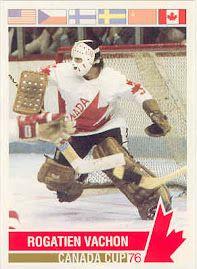
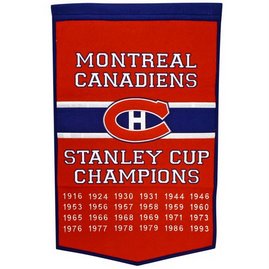







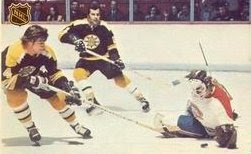



















































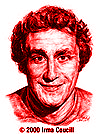



































































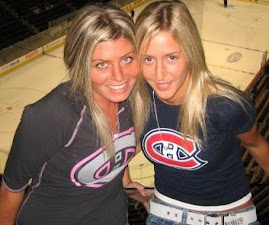


















No comments:
Post a Comment